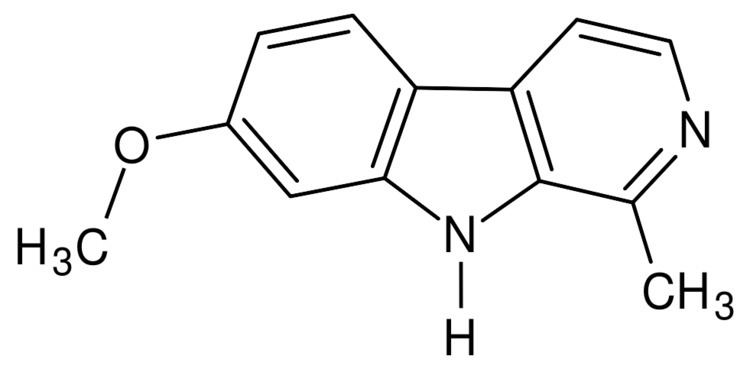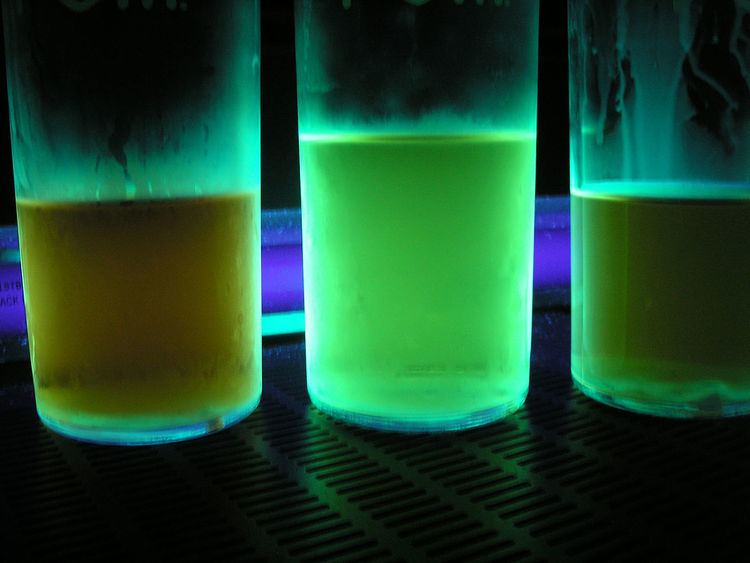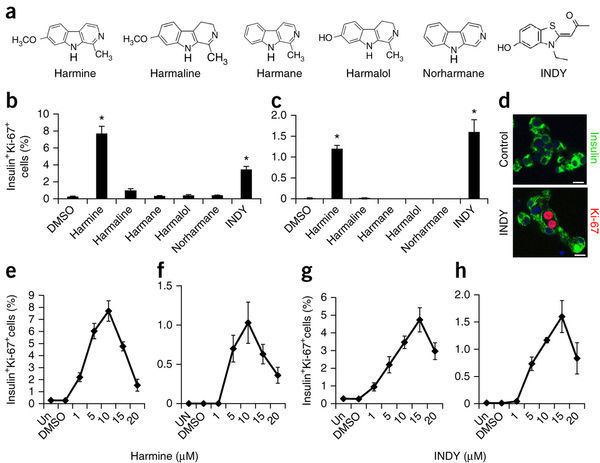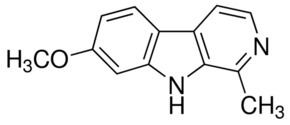Formula C13H12N2O Melting point 321 °C | Molar mass 212.25 g/mol | |
 | ||
Harmine, also known as telepathine, is a fluorescent harmala alkaloid belonging to the beta-carboline family of compounds. It occurs in a number of different plants, most notably the Middle Eastern plant harmal or Syrian rue (Peganum harmala) and the South American vine Banisteriopsis caapi (also known as "yage" or "ayahuasca"). Harmine reversibly inhibits monoamine oxidase A (MAO-A), an enzyme which breaks down monoamines, making it a RIMA. Harmine selectively binds to MAO-A but does not inhibit the variant MAO-B.
Contents

Biosynthesis

Isolated from the plant Peganum harmala, harmine is an indole alkaloid with the pyrido[3,4-b]indole ring structure that is characteristic of the β-carboline alkaloids. The β-carboline alkaloids include harmine, harmaline, harman and harmalol. These molecules are heterocyclic amines, biosynthesized through the combination of five- and six-membered ring structures that are derived from an amino acid- either L-tryptophan or tryptamine- which facilitates the formation of an indole ring system.

The coincident occurrence of β-carboline alkaloids and serotonin in P. harmala indicates the presence of two very similar, interrelated biosynthetic pathways, which makes it difficult to definitively identify whether free tryptamine or L-tryptophan is the precursor to the biosynthesis of harmine. However, it is postulated that L-tryptophan is the most likely precursor, with tryptamine existing as an intermediate in the pathway.

The following figure shows the proposed biosynthetic scheme for harmine. The Shikimate acid pathway yields the aromatic amino acid, L-tryptophan. Decarboxylation of L-tryptophan by aromatic L-amino acid decarboxylase (AADC) produces tryptamine (I), which contains a nucleophilic center at the C-2 carbon of the indole ring due to the adjacent nitrogen atom that enables the participation in a mannich-type reaction. Rearrangements enable the formation of a Schiff base from tryptamine, which then reacts with pyruvate in II to form a β-carboline carboxylic acid. The β-carboline carboxylic acid subsequently undergoes decarboxylation to produce 1-methyl β-carboline III. Hydroxylation followed by methylation in IV yields harmaline. The order of O-methylation and hydroxylation have been shown to be inconsequential to the formation of the harmaline intermediate. In the last step V, the oxidation of harmaline is accompanied by the loss of water and effectively generates harmine.

The difficulty distinguishing between L-tryptophan and free tryptamine as the precursor of harmine biosynthesis originates from the presence of the serotonin biosynthetic pathway, which closely resembles that of harmine, yet necessitates the availability of free tryptamine as its precursor. As such, it is unclear if the decarboxylation of L-tryptophan, or the incorporation of pyruvate into the basic tryptamine structure is the first step of harmine biosynthesis. However, feeding experiments involving the feeding of one of tryptamine to hairy root cultures of P. harmala showed that the feeding of tryptamine yielded a great increase in serotonin levels with little to no effect on β-carboline levels, confirming that tryptamine is the precursor for serotonin, and indicating that it is likely only an intermediate in the biosynthesis of harmine otherwise comparable increases in harmine levels would have been observed.
Uses

Monoamines include neurotransmitters (serotonin, dopamine), hormones (melatonin, epinephrine, norepinephrine) and psychedelic drugs (psilocybin, DMT and mescaline). By slowing the breakdown of neurotransmitters, monoamine oxidase inhibitors (MAOIs) can help to replenish the body's supply of these chemicals, and many MAOIs are used as antidepressants. Harmine has not been the subject of much clinical research in the treatment of depression, which could be due in part to its restricted legal status in many countries, as well as the existence of synthetic MAOIs with fewer side effects.
P. harmala and B. caapi are both traditionally used for their psychoactive effects. B. caapi has a tradition of use in conjunction with plants containing the drug DMT. Traditionally, B. caapi is consumed as a drink, with or without the DMT-bearing plants (see Ayahuasca). Ordinarily, DMT is not active when taken orally, but users report very different effects when MAOIs are present in such beverages. Harmine and substances containing it have been used in conjunction with many other drugs by modern experimenters. Many hallucinogens appear to exhibit increased potency when used in this way.
Harmine is also a useful fluorescent pH indicator. As the pH of its local environment increases, the fluorescence emission of harmine decreases.
With the radioisotope carbon-11 harmine is used in positron emission tomography neuroimaging to examine its binding to MAO-A.
Harmine found in root secretions of Oxalis tuberosa has been found to have insecticidal properties.
Harmine has been found to increase EAAT2 glutamate pump expression in central nervous system, therefore reducing glutamate toxicity.
Anticancer
"Harmine showed cytotoxicity against HL60 and K562 cell lines. This could explain the cytotoxic effect of P. harmala on these cells."
Effects on bone and cartilage
"Harmine was shown to promote differentiation of osteoblasts (bone-forming cells), and chondrocytes (cells in the cartilage)."
It was also shown to inhibit osteoclastogenesis (the formation of bone resorbing cells)
Adverse effects
Harmine, and plants containing significant amounts of harmine and other harmala alkaloids are generally not considered safe treatments for depression within the medical community. This bias however is primarily built on previous decades of experience with pharmaceutical non-specific MAOIs that block both MAO-A and MAO-B. Inhibiting MAO-A or MAO-B (in high enough doses) while consuming foods rich in tyramine, e.g. cheese, can cause tyramine, ordinarily metabolized by these enzymes, to accumulate to dangerous levels. This can cause a potentially fatal hypertensive crisis. Because harmine reversibly and selectively inhibits MAO-A and does not degrade MAO-B, MAO-B remains free to metabolize tyramine in the digestive tract. Consequently, the harmala alkaloids (including harmine) are unlikely to elicit tyramine-mediated hypertensive crisis, and a special diet does not need to be so strictly adhered to. Nonetheless, due to the reduction of the levels of tyramine degrading compounds in the gut, it is still not advisable to eat excessively large amounts of tyramine-rich food products. The reversibility and MAO-A selectivity of harmala alkaloids do not, however, prevent potentially fatal interactions with common medications such as antihistamines, most antidepressants, many stimulants, common migraine medications, some herbs, decongestants, expectorants, and common cough and cold medications.
It has recently been shown in the Journal of Photochemistry and Photobiology B: Biology that beta-carboline MAO inhibitors, such as harmine, bind with DNA and also exhibit anti-tumor properties. Harmine has been shown to bind one hundred times more effectively than its close analogue harmaline. The consequences of this are currently not well understood.
Rapid discontinuation of MAO inhibitors can cause serious withdrawal syndrome.
Overdosage
Oral or intravenous harmine doses ranging from 30–300 mg have caused agitation, bradycardia or tachycardia, blurred vision, hypotension, paresthesias and hallucinations. Serum or plasma harmine concentrations may be measured as a confirmation of diagnosis. The plasma elimination half-life is on the order of 1–3 hours.
Australia
Harmala alkaloids are considered Schedule 9 prohibited substances under the Poisons Standard (October 2015). A Schedule 9 substance is a substance which may be abused or misused, the manufacture, possession, sale or use of which should be prohibited by law except when required for medical or scientific research, or for analytical, teaching or training purposes with approval of Commonwealth and/or State or Territory Health Authorities.
Exceptions are made when in herbs, or preparations, for therapeutic use such as : (a) containing 0.1 per cent or less of harmala alkaloids; or (b) in divided preparations containing 2 mg or less of harmala alkaloids per recommended daily dose.
